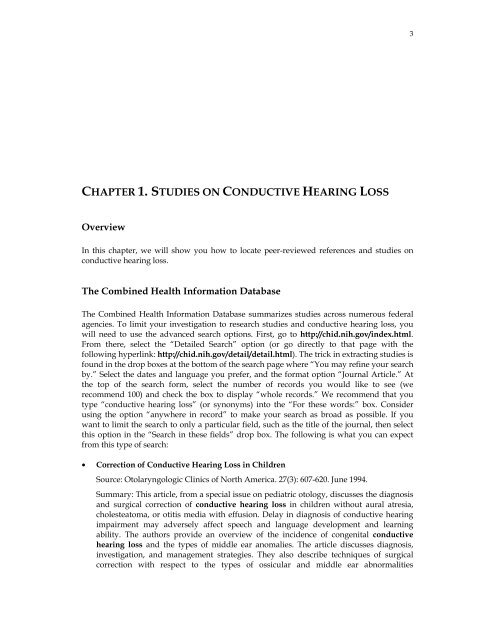conductive hearing loss dictionary
conductive hearing loss dictionary
conductive hearing loss dictionary
- No tags were found...
You also want an ePaper? Increase the reach of your titles
YUMPU automatically turns print PDFs into web optimized ePapers that Google loves.
3CHAPTER 1. STUDIES ON CONDUCTIVE HEARING LOSSOverviewIn this chapter, we will show you how to locate peer-reviewed references and studies on<strong>conductive</strong> <strong>hearing</strong> <strong>loss</strong>.The Combined Health Information DatabaseThe Combined Health Information Database summarizes studies across numerous federalagencies. To limit your investigation to research studies and <strong>conductive</strong> <strong>hearing</strong> <strong>loss</strong>, youwill need to use the advanced search options. First, go to http://chid.nih.gov/index.html.From there, select the “Detailed Search” option (or go directly to that page with thefollowing hyperlink: http://chid.nih.gov/detail/detail.html). The trick in extracting studies isfound in the drop boxes at the bottom of the search page where “You may refine your searchby.” Select the dates and language you prefer, and the format option “Journal Article.” Atthe top of the search form, select the number of records you would like to see (werecommend 100) and check the box to display “whole records.” We recommend that youtype “<strong>conductive</strong> <strong>hearing</strong> <strong>loss</strong>” (or synonyms) into the “For these words:” box. Considerusing the option “anywhere in record” to make your search as broad as possible. If youwant to limit the search to only a particular field, such as the title of the journal, then selectthis option in the “Search in these fields” drop box. The following is what you can expectfrom this type of search:• Correction of Conductive Hearing Loss in ChildrenSource: Otolaryngologic Clinics of North America. 27(3): 607-620. June 1994.Summary: This article, from a special issue on pediatric otology, discusses the diagnosisand surgical correction of <strong>conductive</strong> <strong>hearing</strong> <strong>loss</strong> in children without aural atresia,cholesteatoma, or otitis media with effusion. Delay in diagnosis of <strong>conductive</strong> <strong>hearing</strong>impairment may adversely affect speech and language development and learningability. The authors provide an overview of the incidence of congenital <strong>conductive</strong><strong>hearing</strong> <strong>loss</strong> and the types of middle ear anomalies. The article discusses diagnosis,investigation, and management strategies. They also describe techniques of surgicalcorrection with respect to the types of ossicular and middle ear abnormalities











